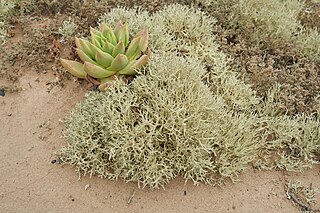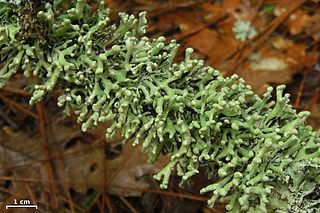
Depsidones (+ "depside" + "one") are chemical compounds that are sometimes found as secondary metabolites in lichens. They are esters that are both depsides and cyclic ethers. An example is norstictic acid. [1]

Depsidones (+ "depside" + "one") are chemical compounds that are sometimes found as secondary metabolites in lichens. They are esters that are both depsides and cyclic ethers. An example is norstictic acid. [1]

A depside is a type of polyphenolic compound composed of two or more monocyclic aromatic units linked by an ester group. Depsides are most often found in lichens, but have also been isolated from higher plants, including species of the Ericaceae, Lamiaceae, Papaveraceae and Myrtaceae.

Niebla is a genus of yellow-green fruticose lichens that grow on rocks, trees, and shrubs within the fog zone of coastal North America, or more narrowly defined to occur on rocks and soil along the Pacific Coast from Mendocino County in California south to Baja California Sur.
Menegazzia foraminulosa is a species of corticolous (bark-dwelling), foliose lichen that is endemic to New Zealand. The lichen was first formally described as a new species in 1876 by August von Krempelhuber. Friedrich Bitter transferred it to the genus Menegazzia in 1901. The species contains several lichen products, including depsides, depsidones, as well as fatty acids and pigments.
A spot test in lichenology is a spot analysis used to help identify lichens. It is performed by placing a drop of a chemical on different parts of the lichen and noting the colour change associated with application of the chemical. The tests are routinely encountered in dichotomous keys for lichen species, and they take advantage of the wide array of lichen products produced by lichens and their uniqueness among taxa. As such, spot tests reveal the presence or absence of chemicals in various parts of a lichen. They were first proposed by the botanist William Nylander in 1866.

Norstictic acid is a depsidone produced as a secondary metabolites in lichens.
Vermilacinia cedrosensis is a species of pale fruticose lichen that is endemic to Baja California, Mexico.
Vermilacinia cephalota is a fruticose lichen usually found on trees, shrubs and wooden fences in the fog regions along the Pacific Coast of North America from southeastern Alaska to the Vizcaíno Peninsula of Baja California.
Vermilacinia cerebra is a fruticose lichen that grows on trees and shrubs in the fog regions along the Pacific Coast of North America from the Channel Islands and mainland California near Los Angeles to southern Baja California, also occurring in South America in the Antofagasta Province of northern Chile. The epithet is in reference to the apical swollen lobes that resemble the cerebrum of the brain.
Vermilacinia tigrina is a fruticose lichen that grows on branches of shrubs and on earth among cactus and shrubs in the fog regions along the Pacific Coast of North America and South America; in North America found in the Channel Islands and near San Diego, California, and in central and southern Baja California; and in South America from Peru to Chile. The epithet is in reference to the irregular black spots or bands on the thallus branches.

Niebla arenaria is a fruticose lichen that grows along the Pacific Coast of North America in the fog regions of the northern peninsula of Baja California from near Colonet south to Morro Santo Domingo. The epithet, arenaria, is in regard to the species growing on sand.
Niebla dissecta is a fruticose lichen that grows on rocks along the Pacific coast of California, in San Mateo County and in the Channel Islands. The epithet dissecta is in reference to the thallus repeatedly divided into branches.
Niebla josecuervoi is a fruticose lichen that grows on rock, stony soil and sand along the Pacific Coast of northern Baja California from near Misión San Vicente Ferrer to Punta Santa Rosalilillita. The epithet, josecuervoi is in honor of a field assistant, “Jose Cuervo”.
Niebla pulchribarbara is a rare fruticose lichen that occurs on sandy beaches or gravelly soil along the Pacific Coast, at San Antonio del Mar and at Bahía de San Quintín, Baja California. The species epithet, pulchribarbara, is in reference to the strikingly beautiful lichen mat formed by the thallus.
Niebla spatulata is a fruticose lichen that grows on small rocks along the foggy Pacific Coast of central Baja California in the Vizcaíno Desert. The epithet, spatulata is in reference to the flattened branches of the thallus, in contrast to another similar species, Niebla flabellata.
Remototrachyna is a genus of foliose lichens in the large family Parmeliaceae. It was separated from the genus Hypotrachyna based on the structure of the excipulum and genetic differences.

Hypogymnia tubulosa is a species of foliose lichen in the family Parmeliaceae. Ludwig Emanuel Schaerer formally described it in 1840 as a variety of Parmelia ceratophylla. Johan Johnsen Havaas promoted it to distinct species status in 1918.

Rhizocarpales are an order of lichen-forming fungi in the subclass Lecanoromycetidae of the class Lecanoromycetes. It has two families, Rhizocarpaceae and Sporastatiaceae, which contain mostly crustose lichens.

Salazinic acid is a depsidone with a lactone ring. It is found in some lichens, and is especially prevalent in Parmotrema and Bulbothrix, where its presence or absence is often used to help classify species in those genera.
Parmotrema lichexanthonicum is a species of foliose lichen in the family Parmeliaceae. Found in Brazil, it was formally described as a new species in 1997 by Sionara Eliasaro and Mónica Adler. The type specimen was collected by the first author from the Serra do Cipó ; here the lichen was found growing on a rock. The specific epithet lichexanthonicum refers to the presence of the secondary compound lichexanthone in the medulla of the lichen. Other compounds in the lichen are the depsidone salazinic acid, and the depside atranorin. A close relative to this species is Parmotrema ultralucens, which contains the same cortical and medullary metabolites.
Lichen products, also known as lichen substances, are organic compounds produced by a lichen. Specifically, they are secondary metabolites. Lichen products are represented in several different chemical classes, including terpenoids, orcinol derivatives, chromones, xanthones, depsides, and depsidones. Over 800 lichen products of known chemical structure have been reported in the scientific literature, and most of these compound are exclusively found in lichens. Examples of lichen products include usnic acid, atranorin, lichexanthone, salazinic acid, and isolichenan, an α-glucan. Many lichen products have biological activity, and research into these effects is ongoing.